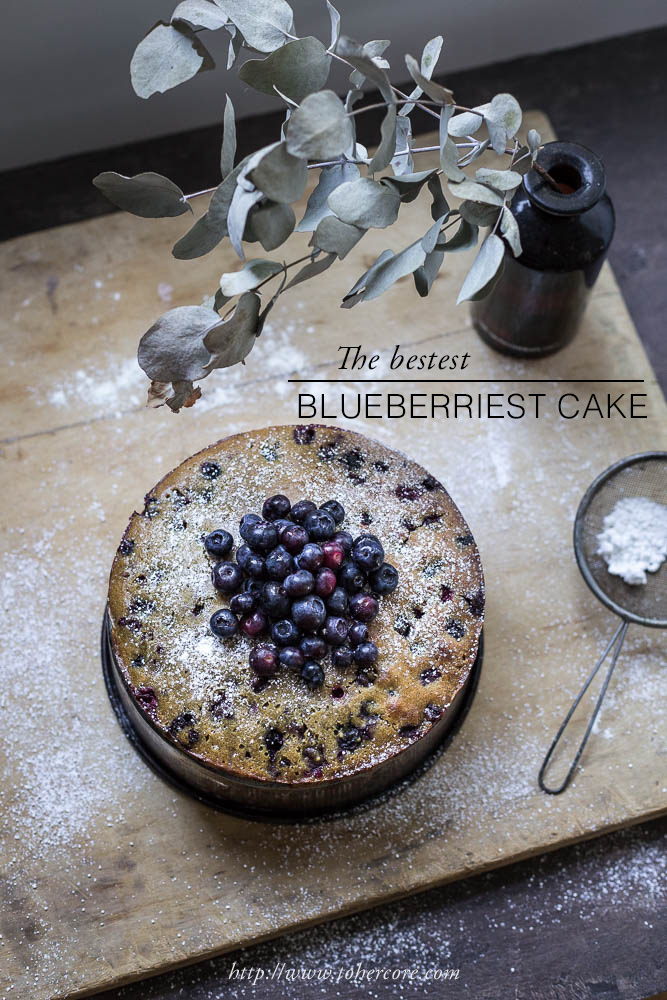
It’s been a while since I spoke about my diet or how I choose to eat on here (I think this was perhaps the last post, written back in 2014). While I still follow a plant-based diet, and nearly all of what I wrote in that last post still rings true, my daily diet has changed quite a bit since then, and I thought this cake would be the perfect recipe to share with a chit chat about diet.
Back when I started the blog in 2013, I was all about eating a healthy, plant-based diet full of in vogue foods – raw desserts, veggie replacements for carbs and green smoothies. I would snack on energy bites/bliss balls packed with dates, almonds and coconut, and slurp down veggie smoothies made with a banana and avocado base. I’d top my oatmeal with bee pollen, raw cacao nibs and dried goji berries, and my beloved pasta and pizza were replaced with zoodles (zucchini noodles) and broccoli bases (never was a fan of the cauliflower base!) Initially, they were hard to come by, so I was ecstatic when ‘clean eating’ gained in popularity and my local big supermarket chains started stocking their own brands of these expensive items, making them slightly more affordable.
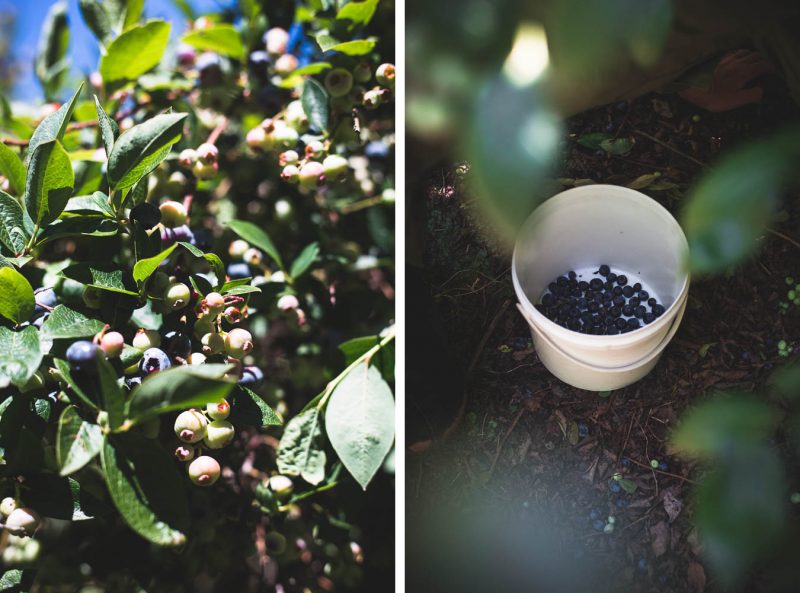
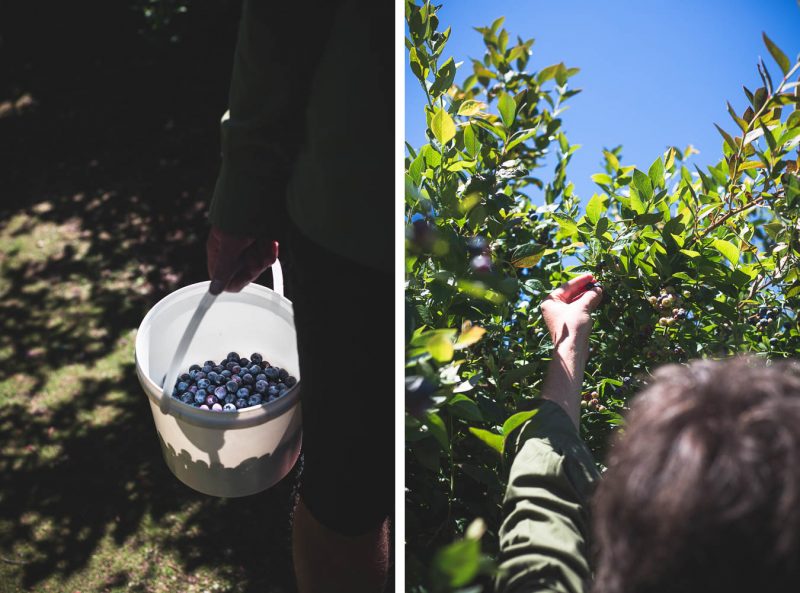
But never during this time did I really think about where any of these foods came from. I would make bliss balls from almonds and pecans because that’s what everyone on the internet was doing, despite the fact that neither grew in Tasmania. Avocado, banana, dates and coconut formed the base of most of my sweet treats – again, foods that didn’t grow in the cooler Tasmanian climate (though you can now get locally grown avocados).
I became more and more aware of the food miles taken to get this food to where I lived. I started to question the low prices in the supermarkets that I had originally revelled in. How was it possible the the food was able to be grown (organically), packaged and shipped to Australia and now being sold for half the price of what it was elsewhere. And how was it possible that “fresh” apples were available in supermarkets year round, despite the fact that – living in what is dubbed “The Apple Isle” – I knew for a fact that the apple season only spanned the first few months of the year. Reading articles such as this one which highlighted how fresh fruit and vegetables were processed for supermarkets led us to stop buying fruit and vegetables from the supermarket, instead sourcing them from local suppliers through fortnightly delivered boxes or farmers markets.
And more recently, we have extended this to other foods we grow as well. Nowadays, we try to source as much of our food from local producers as we can. There are obviously a few exceptions to this, and I still go to the supermarket about once every month or two to stock up on a few things that it’s harder to source elsewhere (the main one for me being organic tampons – still can’t work out why the main supermarkets are the only ones who stock these!) But for the most part we try to buy things from small, locally owned shops or direct from the grower/manufacturer where possible. It’s nice to know that the money is going direct to the producers and makers, rather than them only being paid a fraction while a larger company rakes in the profits. It’s also nice to know that the food miles are low, and thus the environmental impact is lessened. And it can also force you to get creative in the kitchen – though I still buy some ingredients that aren’t local, the bulk of our produce is, and is therefore seasonal which means that we only have access to most fruit and vegetables for certain parts of the year. Learning to incorporate different seasonal vegetables into dishes where I might have always reached for the same veggie in the past has forced me to expand my repertoire and try new things (results of which have been a little hit and miss, but always fun experimenting!)
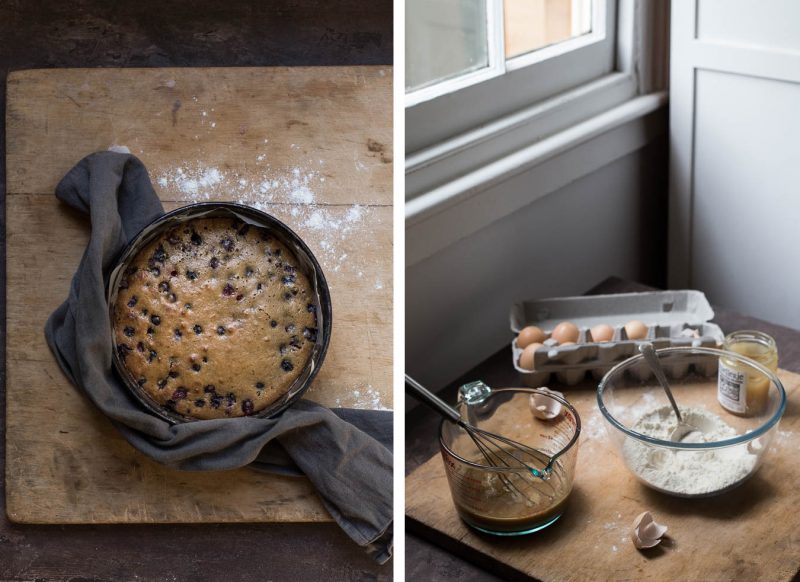
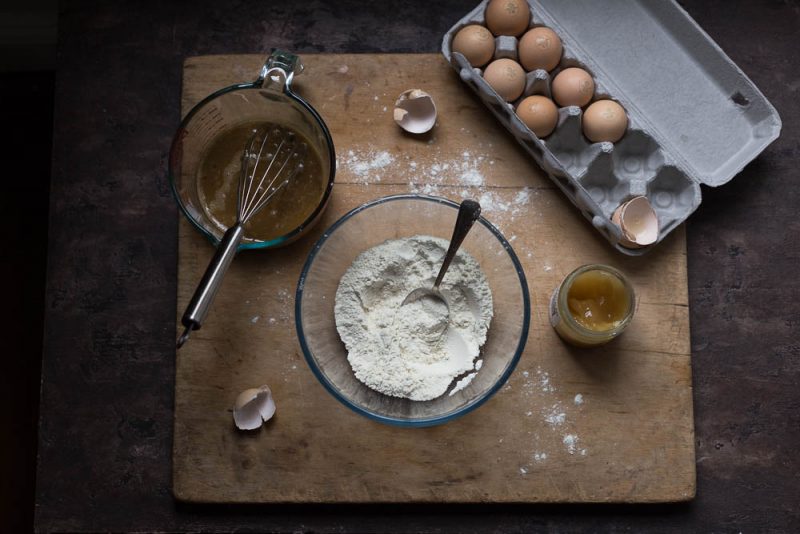
So, to this cake! I have been making this for nearly ten years, and I have no idea where the original recipe came from, but it’s one that has been tweaked and changed over the years to become what it is today. It was the favorite cake of an old flatmate of mine, who deserves full credit for coming up with the name (far catchier than “that blueberry cake”). It’s made nearly entirely of local ingredients (except the baking powder) – we even picked the blueberries ourselves. The flour is spray-free and grown and ground at Callington Mill in the middle of the state. It’s sweetened with a mix of local leatherwood honey, with a touch of yacon syrup, which is made near the small town in which I grew up in the North East of the State. And knowing that it’s made up of all locally sourced ingredients makes it taste that little bit more special :)
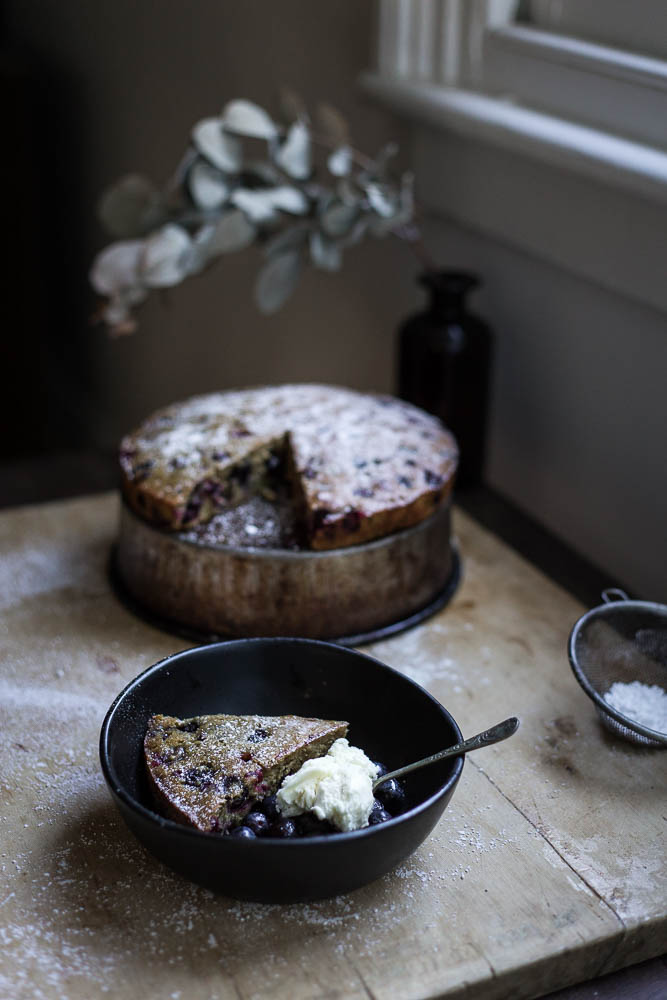
– MAKE IT YOUR OWN –
- Any frozen berries could be here – try raspberries, blackberries, mulberries etc
- I use a mix of leatherwood honey and yacon syrup to sweeten the cake, as well as adding flavour. If you want the sweetness without the added flavour, you could try using rice malt syrup, agave or cane sugar. On the other hand, if you like the idea of added flavour, you could experiment with maple syrup or golden syrup, both which would be delicious here!
- This could easily be made dairy free by using nut milk and coconut oil or olive oil instead of the butter
- I think this cake is perfect as it is, or with just a dusting of icing sugar, but you could ice it. I would choose something not too sweet such as a lemon-y buttercream or cream cheese frosting, or just whipped (coconut or dairy) cream
- For added texture, stir some lightly toasted coconut flakes or chopped pecans or walnuts through the batter before baking
- I have tried to make this with wholegrain flours, but prefer it with all purpose flour. That said, you could easily sub out some of the all purpose flour for a whole grain flour if you wish, noting the texture and taste will be slightly different
- 1 cup plain, all purpose flour
- 1 tsp baking powder
- ½ tsp bicarb soda
- 1/t tsp sea salt
- 5 Tbsp milk
- ½ tsp fresh lemon juice
- ½ cup of liquid sweetener (eg honey, maple syrup, golden syrup, molasses - or a mix of any of these; I use 3 parts honey, one part yacon syrup)
- 2 free-range eggs
- ¼ cup (50g) organic butter, melted
- 1.5 cups frozen blueberries
- Preheat oven to 170 C | 340F
- Mix the dry ingredients together in a bowl.
- In a second bowl, mix together the milk, lemon juice and sweetener. Mix in the two eggs, and then stir in the melted butter. Lastly, stir through the frozen blueberries.
- Pour into a lined and greased 20cm | 8" cake pan.
- Bake for around 25 - 30 minutes - it's done when a knife comes out clean. Allow to sit in the pan for 10 minutes, and then run a knife around the edges to release it from the pan, and turn out onto a rack to cool completely - note however this cake is best enjoyed slightly warm, so feel free to tuck in straight away!
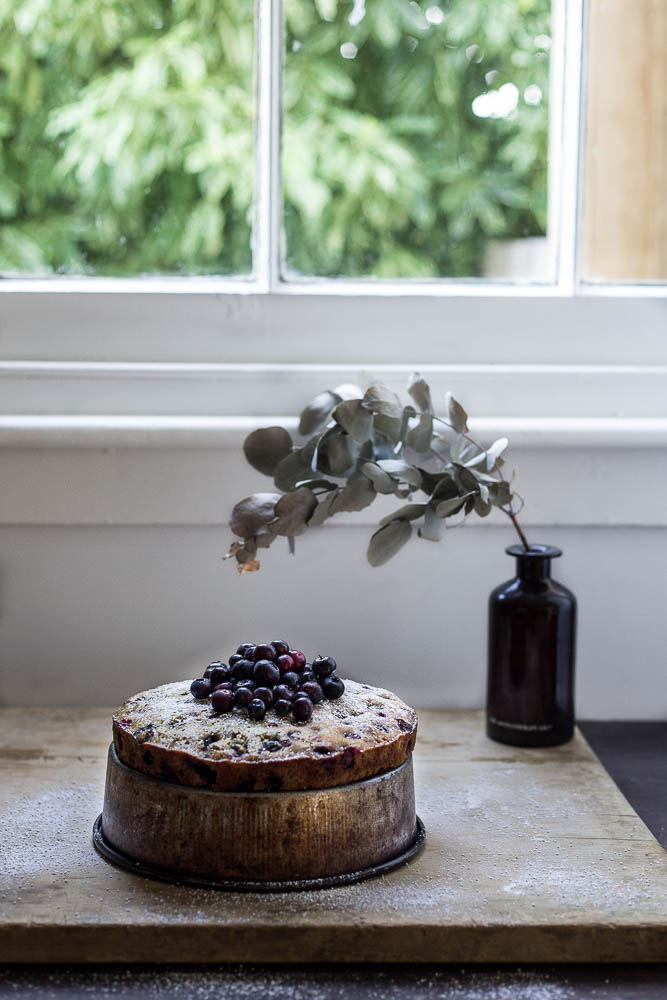
Thank you so much for this post. You have described perfectly what I find problematic about this whole “clean-eating” trend. I was also pretty interested and hooked when I first stumbled upon some of the recipes. I didn´t go all the way because as a broke college student, I just couldnt afford many of those things. But I also tried it all out and ate a lot of things, that would never ever grow in the cold climate of Northern Europe. At some point I started to think a bit more critically, I don´t really now what the whole trigger was for that. But I completely agree with you, we should really think way more critically where our food comes from and whether or not there aren´t things that are just as tasty, healthy, good for you or delicous but might grow in your backyard. We don´t need chia seeds all day when flax seeds are just as great, or goji berries when blueberries do the same trick. Same with strawberries in winter. Yes, I still eat avocados and bananas but overall, I try to eat as seasonal as possible which can also be a lot of fun, figuring out what to do with something you have neglected for all these years. :)
YES! It’s a little hard to see past the allure at first, especially when everything seems so (legitimately) healthy. But I think with anything, you need to look at it holistically, and for me environmental impact, community impact (supporting local suppliers) are really important as well. And of course, the cost plays a factor at the same time. Thanks for sharing your thoughts Ineke x
Yes, I agree… the ‘clean eating’ trend has become a buzzword for a popular fad, when it should in fact be a lifestyle! It shouldn’t be a diet, it shouldn’t be a #eatclean to gain insta or facebook followers – it should be what we eat every day, in balance. That’s why I like this cake recipe. Sure, it’s not exactly ‘clean’, but you know what? You’ve used wholefoods, sustainable and LOCALLY sourced ingredients. And to me, that’s all that matters. It sure is the ‘bestest’ argument for sustainable eating (and not just focusing on the ‘superfood’ hype). Thank you for sharing Dearna, it’s much appreciated and you’re not alone in your views at all.
Thank you so much Rosie! I totally agree – it should definitely be a lifestyle that incorporates other factors – importantly that the food is sourced sustainably. I’m glad I’m not the only one in thinking this :)
lovely, as always dearna. the local vs. commercially “healthy” thing is something i think about a lot. i find myself going through phases of prioritizing different aspects of our food. there have been times when most of our food has come from our local CSA, supplemented with some bulk items we get from the grocery store. now, money is tighter, so we have found ourself getting what’s cheap and healthy. because of our system of capital, that usually means faraway sourced. in the future i hope to find a much better balance. thanks as always for sharing your thoughts and process here.
also! this might be weird to include in a comment on a beautiful food blog post, but, you said ‘organic tampon’ and it sent my mind a-whirling: have you ever tried (or heard of) a menstrual cup? i have used a lunette now for probably over 5 years, and used a mooncup for several years before before that. there are tons of companies from all over making menstrual cups now (though i’d avoid getting a divacup if you’re trying it for the first time; they’re weird-shaped and not forgiving). i haven’t had to buy a single disposable menstrual product in over 10 years, and i feel really good about that. just wanted to pass along the info to you or anyone else who might be interested in alternative menstrual products. xoxo
So frustrating that cheap and healthy often means not being able to buy local isn’t it! Just this morning I was at the grocer and there were four type of stone fruit – one local, and three from interstate. The interstate ones were half the price! And it’s worse if your looking for things like grains or nuts/seeds, which are a lot cheaper if you buy imported products. It does make it hard when you’re trying to watch your spending!
Haha, your last bit made me giggles – of course it’s fine to post here :) I actually haven’t ever considered a menstrual cup – the idea grossed me out when I was younger and I just haven’t thought about it since then! But I should – so thank you for the recommendations :)
Ooh a big yes to this cake! (or at least once blueberries are in season here.) Gorgeous pictures too Dearna.
Thanks for making an argument for local and seasonal not because it’s trendy and “clean” but because it’s sustainable for the environment, raises personal awareness of treatment of workers and improves our connection with nature and seasonal rhythms.
And I’d like to add to the tampon discussion too! ;-) Jaime has made a convincing argument for menstrual cups. I also want to put a plug in for Thinx (reusable period underwear)!
https://www.shethinx.com/
Not sure if they’re shipping to Australia yet but for North American readers looking for a more sustainable lining/overnight solution, this is it! I was skeptical at first but absolutely love them. They’re silky and feel really good on and dare I say they make me look forward to my period (or at least tolerate it more ;-).
Okay, I definitely think I need to give my sanitary products some more consideration! Thank you for your suggestions Katie :)
While I agree that the bulk of our diets should be locally sourced I also see the importance of trade. Trade is nothing new; ships from India delivered spices to Europe for example. There were land trade routes developed as means of exchange and to boost economy. If I buy fair trade sustainably grown mangos for example from Mexico or Peru I feel like I supported the less developed regions. Agriculture and export is oftentimes their only source of income… so in my opinion there are two sides to every coin.
Let’s have some fair trade chocolate!!
Eating holistically also means paying attention to the energetics of food.. raw fruit in cold winter climate is probably not optimal … stick to a bowl of steaming lentil stew… oh wait Canada is the main exporter of lentils… hmmm…so should I give up lentils?? Trade is important and many regions rely on imported foods, especially mountainous or desert regions.
Hi Gabriela – a very good point you make. And while I agree that trade is an important part of our global economy (both in terms of food as well as other goods), I do think that overall we need to look more closely at where our food comes from. The point I was trying to make is that when quinoa grown in Peru and sold at the large-chain supermarkets is half the price of quinoa grown 20km down the road and sold at the local market – how is this possible? Food at the supermarkets seem to be getting cheaper and cheaper, and yet they are posting higher returns than ever…
I totally understand that for some people buying everything locally isn’t an option, but I do think that overall we need to look at where our food comes from and how it is sourced.
– D
Well, wages around the world differ greatly! It is part of the “problem” with the prices and yes, of course production on a larger scale will be cheaper. I fully agree with what you are saying. This is a little different topic but how is it that our society values IT professionals more than farmers and chefs? Farmers and kitchen help gets paid nothing compared to someone who maintains computers… that’s the sad part.
You know I grew up under communism in Czechoslovakia and I KNOW what local is… when there’s literally no import and you chew on shriveled up apples in March (harvested last September) :) I also remember the excitement when we got the exotic fruit like bananas :)) … and unfortunately McDonald’s too… I could write a novel on this.
Nothing is just black or white…
Funny that you mention the wages paid to chef/kitchen hands – just this week the penalty rates that these staff receive for working weekends have just been slashed in Australia which I think is indicative to a degree of the low value that the Government (and arguably, some of the general population as well) places on their work. Why is it that their time is less valuable than that of a someone else that works on weekends?
I can’t even imagine what it would be like to grow up in a time of war, I totally understand that “eating local” (and a lot of other things that we have a choice on in the industrialised western world) would not be possible during these times. What a tough time this must have been for you and your family!
And you are right – these issues are incredibly complex and not so straight forward, it would be very easy to write a million posts about this!